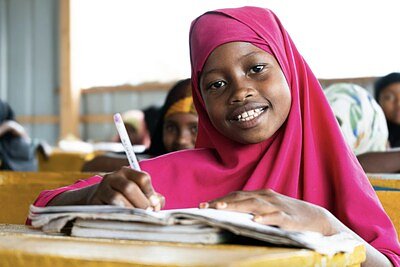
Somalia's Education Lifeline: Anticipating Crisis to Keep Children Learning
As climate shocks and conflict displace millions of Somali children, a new approach focuses on predicting crises to keep education going – and build resilience for the future.
Somalia's Education Lifeline: Anticipating Crisis to Keep Children Learning
By Debra Allen
Jowhar, Somalia – Amidst recurring droughts, devastating floods, and decades of conflict, Somalia faces a crippling education crisis. Nearly 5 million children are out of school, and displacement continues to disrupt learning for countless more. But a growing movement is shifting the focus from responding to crises, to anticipating them – and a new initiative led by Education Cannot Wait (ECW) and the Norwegian Refugee Council (NRC) is at the forefront of this paradigm shift.
For children like 10-year-old Sundus, who recently found herself displaced by flooding, the disruption to her education could have been catastrophic. But thanks to pre-planned interventions, temporary learning spaces were established, ensuring she and other displaced children could continue their schooling. “It’s a relief to know my children are still learning, even when everything else is chaotic,” said a local parent, speaking anonymously. “Before, when we were displaced, education always stopped.”
A Shift Towards Anticipatory Action
The traditional humanitarian model is often reactive, mobilizing resources after a disaster strikes. However, Somalia’s predictable climate shocks – particularly droughts and floods linked to El Niño patterns – are driving a move towards “anticipatory action.” This approach, gaining traction globally, involves utilizing early warning systems and risk analysis to pre-position resources, establish partnerships, and develop plans before a crisis unfolds.
“The key is to move beyond simply putting out fires,” explains a humanitarian aid worker familiar with the program, speaking anonymously. “We need to understand the risks, prepare for them, and act before they escalate. This isn't just about providing textbooks; it’s about building resilience into the education system.”
ECW, with its significant $64 million investment in Somali education, is central to this effort. The organization focuses on multi-year resilience programs, working with partners like NRC to establish sustainable learning opportunities. NRC’s long-standing presence in Somalia provides critical on-the-ground expertise, allowing for effective implementation of programs like the establishment of temporary learning spaces and teacher training.
Predicting the Unpredictable: How It Works
The anticipatory approach in Somalia relies heavily on climate forecasting and risk assessments. Organizations like the Food and Agriculture Organization (FAO) provide detailed predictions of drought and flood patterns, allowing aid agencies to prepare accordingly.
“We identify vulnerable communities and pre-position resources – textbooks, learning materials, even temporary classroom structures – based on predicted rainfall levels and flood risks,” explains an aid worker involved in the program. “The goal is to minimize disruption and ensure children can continue learning, even during a crisis.”
This doesn’t just involve material resources. Pre-planned teacher training ensures educators are equipped to provide psychosocial support to students experiencing trauma and to adapt their teaching methods to emergency situations.
A System Under Strain
Despite these advancements, Somalia’s education system remains deeply fragile. Conflict and insecurity continue to displace communities, destroy school infrastructure, and disrupt learning. Poverty forces many families to prioritize survival over education, and girls, particularly in rural areas, face significant barriers to accessing schooling.
“The challenges are immense,” admits a government official involved in education planning, speaking anonymously. “We’re dealing with decades of conflict, climate change, and limited resources. It’s not enough to just anticipate crises; we need long-term investment in infrastructure, teacher training, and curriculum development.”
The sheer scale of the out-of-school population – nearly 5 million children – presents a significant hurdle. Even successful programs struggle to reach all those in need, and ensuring quality education for all remains a distant goal.
Beyond Immediate Relief: Building a Resilient Future
The shift towards anticipatory action represents a crucial step towards building a more resilient education system in Somalia. However, it's not a silver bullet. Sustained investment, long-term planning, and a collaborative approach are essential to address the underlying challenges facing the sector.
“We need to move beyond simply providing emergency relief and focus on building sustainable systems,” says a representative from a donor organization involved in supporting Somali education, speaking anonymously. “This means investing in teacher training, curriculum development, and infrastructure, and working with local communities to ensure that education is accessible and relevant to their needs.”
For children like Sundus, the anticipatory approach offers a glimmer of hope amidst the chaos. It's a reminder that even in the face of adversity, education can continue, providing a pathway to a brighter future. But realizing that future requires a collective commitment to building a more resilient and equitable education system for all of Somalia’s children. The ongoing efforts, while promising, demonstrate that consistent investment and long-term commitment are paramount to overcoming the systemic challenges that plague the nation’s education sector. Only then can Somalia truly unlock the potential of its next generation and break the cycle of conflict and poverty.
📝 This article is still being updated
Are you a relevant expert who could contribute your opinion or insights to this article? We'd love to hear from you. We will give you full credit for your contribution.
Contribute Your Expertise →